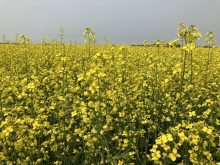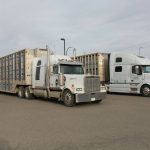Age verification
With a Shakespearean resonance: To age verify or not to age verify, that is the question.
Our beef industry in Canada is in a quandary as it stands at the crossroad in reaching a policy decision vis-à-vis this issue.
Your editorial of Nov. 8 raises the merits of age verification and supports the rejection of producers that it be mandatory.
As a delegate in Zone 8 of the Alberta Beef Producers, I expressed my concerns at the semi-annual meeting this past June that it not remain voluntary.
Read Also

Surviving a bad harvest day sometimes requires a little luck
Producer and writer Kevin Hursh shares a day of three potentially disastrous incidents as cautionary tales of farm safety for Prairie farmers in the midst of fall harvest work.
A spokesperson for ABP addressing our meeting stated that there were 1,002 reasons that it should not be mandatory, and in the next breath expressed concern that there was less than 60 percent compliance to age verify.
I expressed concern that compliance would only occur if it were mandatory. I maintained that view at five ABP fall meetings. I have suggested that a stop sign, if it has a purpose to exist cannot be precatory, it must be mandatory with enforcement….
The movement of live cattle, upon the opening of the border, will require that bred heifers and cull cattle be age verified.
Our Canadian Beef Export Federation delegation to Japan, our No. 1 Asian importer, was told that Japan feels that Canada is “dropping the ball on age verification.” I personally feel that we are and I feel that we need to be visionary and proactive. Cost recovery should not obscure our vision on this critical issue.
I recall a producer at a fall meeting in Kitscoty, Alta., standing up in the midst of a controversial and heated meeting relating to ear tagging, both as to the cost of the tag and application, and saying to his fellow producers that the ear tag should be viewed as a cost of production much like an injection of medication.
Cost recovery will come about on its own with time. A mandatory age verification program will trigger technological assistance in streamlining the process and down-sizing the cost of input and more importantly will guarantee ultimate monetary gains in marketing.
Cost recovery, admittedly is important, but I suggest that it cannot become the common denominator of our equations, otherwise we should stop feeding cattle.
Would ear tagging as it now stands exist today if it had been voluntary? Your own comments and those of the numerous reputable beef organizations and producers begs the question, why not mandatory?
– Guy J. Fontaine,
Bonnyville, Alta.
Tricky top end
Re: David Schnell’s letter Dec. 6. David Schnell states the premium prices as of Nov. 21, 2007, for wheat, in Montana and Ontario, was $8.85 and $8.79 respectively.
How many farmers had any stock left at those prices, and what percentage of production was attained at these prices? To get the top end prices consistently, one must be a genius.
An example this fall, in feed wheat, many producers signed a good portion at $4 to see it rise to $6.60. Where is the price premium here, David Schnell?
I’ll relate to my experience in 2002 with canola and flax in the open market system. In late January of that year I noticed canola hovering at around $9 per bu. after languishing all fall of 2001.
I approached the grain buyer and said to him, “Finally farmers have smartened up and are holding out for higher prices.” His response: “Most canola was sold by December for under $8 per bu.” and another rival grain buyer stated “only the bin sweepings are left,” as farmers sold the majority in fall of 2001.
The peak price for canola was over $10 and for flax over $11 by July. It was more luck than anything that I benefited from those prices. These are quite significant losses for the farmers’ pocketbook. No price premiums here, David Schnell, for those who sold in the fall.
Furthermore, farmers are brainwashed to be independent, use the computer, shop around, but where was the market signal in my above example?
Human nature being what it is, on coffee row we tend to brag at how on top we are when we hit a high price, but never hear from farmers who unloaded their commodity at low prices, in desperation, to see prices rise sharply afterward.
Then we blame all our woes on the CWB saying, if only we could market our wheat and barley and have a choice.
Well, the above examples show that farmers have a choice on 30 commodities to lose thousands of dollars. These same “freedom fighters,” after the dismantlement of the CWB, will cry to government “help us please with these low commodity prices.”
You can’t have it both ways. If you truly believe in the open market system, you can’t ask for taxpayers dollars to bail you out. We see the same problem in the hog industry where corporations and farmers are lobbying government for financial assistance.
This open market system is not a panacea for all or troubling times on the farm. Cost of production is the problem.
– Chris Derbowka,
Dufrost, Man.
A little stinkum
My sentiments exactly – “Too much primp” (Margaret Leigh’s letter, Dec. 6 about cattle shows). I also agree with her about the Barbie doll contests; hair out of a bottle, face out of a jar, and hardware everywhere.
Where does one go to find good cattle?
And as a single and still searching farm boy, where does one encounter women that wear only soap and water and a little stinkum nice?
And if it’s not too much to ask, Santa, could she rope and be good at ‘rithmetic, too?
– Tom Lamont,
Maidstone, Sask.
NDP claims
Re: “Feds spend $1.2 million on barley campaign” (WP, Dec. 6.)
The government of Canada is committed to giving western Canadian farmers the right to choose how to market their own barley as they requested in the plebiscite last spring.
In Adrian Ewins’ Dec. 6 article, he naively reported the NDP’s false claims about the government’s actions during the plebiscite.
This government listens to farmers and communicates with them honestly. We spent $1.2 million to make sure farmers knew who was eligible to vote, when and how to vote, and other key points about the process. We also published the results of the plebiscite, and those results are clear: 62 per cent of western Canadian farmers support marketing choice.
The notices we posted in publications such as the Western Producer were entirely informational and non-partisan. This excerpt is a good example: “The government of Canada is conducting a plebiscite among western Canadian producers to give them a voice on how they wish to market barley.”
It is unfortunate that Mr. Ewins failed to balance his piece with comments from both sides of the issue and it is unfortunate he failed to look at the notices that ran in his own paper.
The NDP opposes barley freedom because they do not believe western Canadian farmers are competent enough to make their own marketing decisions.
Every day farmers make complex marketing decisions when they sell canola, lentils and chickpeas. Western Canadian farmers are certainly smart enough to understand the plebiscite questions and they can certainly market their own barley.
This government is working hard to give them that right.
– Gerry Ritz,
Minister of Agriculture
and Minister Responsible for the Canadian Wheat Board,
Ottawa, Ont.
Anderson challenge
David Anderson’s democratic responsibility is to represent the wishes and concerns of the constituents of his riding, not just to toe the party line.
Clearly he would get a failing grade at fulfilling his responsibilities of representing the majority of his constituents when it comes to the CWB. The reality is there are many pro board supporters in his riding, including a re-elected pro board director.Â
In a letter to the editor in the Dec 6 edition of the Western Producer, David Anderson criticized Ken Ritter, the chair of the CWB for not speaking about facts.
I would like to challenge David Anderson to argue this debate with facts and intelligence. Where is the proof that farmers can have the pooling option of the CWB in an open market?
As a result of a very unclear question in the 2007 plebiscite, which confused farmers, there are thousands of farmers across the Prairies waiting to see a business plan from the Conservative government and David Anderson.Â
Is there a business plan that shows that farmers aren’t at risk of losing the CWB pooling option in an open market, seeing as many farmers have been led to believe that this so-called open market will provide value to farmers?
Where are the facts on this, David Anderson? How can you ensure farmers won’t be losing money?
So far the only document that farmers have seen was in 2006, (when) a Conservative study demonstrated that farmers would not have the CWB pooling model in an open market.
It actually didn’t resemble anything like the CWB at all. The business plan resembled nothing more than a model in which producers could buy shares in to a small grain company, turning the CWB into a business that makes a profit for shareholders vs. farmers.
If David Anderson was being honest, he would say that.
The farmers that voted for both an open market and the CWB pooling system deserve some proof that they are going to have the pooling option in an open market.
How are farmers going to receive more value for their product in a system designed to make shareholders rich? Farmers that voted for the CWB already know the truth. When is David Anderson going to speak about facts instead of ideology?
Perhaps David Anderson should try to win this argument with some integrity and intelligence. The only proof we see from David Anderson and the Conservatives is that this argument is about ideology, not political or economic intelligences.
Once again David Anderson has proven that he and the Conservatives are intellectually starved on the CWB issue.
Think about it farmers, if we went to the bank without a plan, what would they say to us?
– Mandy Melnyk,
Grande Prairie, Alta.
Meat eating
Re: “No Meat”, Open Forum, Nov. 29.
I would urge Lesley Fox and anyone else who thinks about not eating meat to study the websites www.westonaprice.org and www.thincs.org and their links.
Dietary saturated fats are very important for the proper utilization of essential fatty acids, among other things.
– Annie Fisher,
Cobble Hill, B.C.
Pooling lesson
Where are the premiums, asks David Schnell in his letter of Dec 6. Mr. Schnell doesn’t seem to understand how pooled prices work.
Schnell has selectively chosen spot market prices from one or two markets and wrongly argues that because the spot market prices are higher than the CWB’s Pool Return Outlook prices, that somehow the CWB is not getting premiums for western Canadian grains.
Does Schnell know what sales prices the CWB is getting in all the markets they sell to compared to their competitors? Since he obviously doesn’t know, then perhaps he is misjudging the CWB’s performance.
Mr. Schnell should know that pooled prices are more or less made up of a weighted average price for each grade and protein from all the markets we sell to, over the entire crop year from Aug.1 to July 31. This means that pooled returns include prices from lower price periods and higher priced periods and to numerous customers.
If Mr. Schnell would like to compare farmers’ weighted average selling price for canola, oats, lentils, U.S. durum and dark northern spring or any other commodity, he would find that very little is sold at the peak of any market. Selectively comparing any spot market high to a pooled price is not sound logic.
While all farmers would like to sell at the peak of markets, very few can or do, as illustrated very well by what happened in the U.S. with durum sales as reported by U.S. grains industry officials.
If Mr. Schnell and other critics of the CWB want a fair comparison of the prices in the U.S. and Canada, then the only fair comparison is weighted average price comparisons taking into account differences in handling costs, freight and foreign exchange.
I am willing to bet that such a comparison of U.S. and Canadian durum sales in 2007-08 will show that Canadian durum farmers, as a group, were paid higher prices on average than their U.S. counterparts because of pooling and the ability of the CWB to sell limited quantities of durum in a short market primarily to the highest paying customers.
Because Canada often has the majority of exportable durum in the world, currently 55 percent, the CWB is able to push durum prices higher with the single desk because there are very few other sellers. This is one of the advantages single desk sellers can have over multiple sellers and will be lost in an open market.
– Ian Cushon,
Oxbow, Sask.
Diluting efforts
I wrote the following article in response to the framework proposal for a “one industry voice (for Saskatchewan cattle producers.)
This article has been refused twice by the Saskatchewan Stock Growers Association executive for printing in the SSGA magazine.
The membership of the SSGA has not decided that one voice is what they want. …
I feel that if (the Saskatchewan Cattle Feeders Associaton) had truly wanted one voice for Saskatchewan’s cattle industry, they could have joined the SSGA. …
The Saskatchewan cow-calf industry has been very well represented by the SSGA. Nearly 100 years of volunteer time and effort has been spent by the directors of the SSGA in a very effective lobby effort on behalf of Saskatchewan’s cow-calf producers.
Anyone that thinks the SSGA does not have the ear of government or is not respected by government hasn’t been very active for at least the last seven years. …
The SSGA is a member-driven organization. We do receive support from checkoff but are not fully funded. Producers that do not agree have the opportunity to apply for a check-off refund. Very few do and I take that as an endorsement of the work the SSGA does on behalf of Saskatchewan’s cow-calf producers.
The SSGA and SCFA do participate in a joint committee, the Saskatchewan Beef Industry Committee. …
Saskatchewan is in the unique position of having a strong organization that speaks for the cow-calf industry.
We are not part of a general farm group or a larger livestock-based organization that has to temper everything it does so as not to offend other sectors.
We all know that what’s good for the grain sector or doesn’t impact the feedlots isn’t always good for the cow-calf sector. Â
As an elected member of the board of directors of the SSGA, I do not support the idea of one organization controlling the check-off dollars and diluting the lobby efforts of the cow-calf sector.
– Michael Burgess,
Big Beaver, Sask.
Help now
Mr. Gerry Ritz, federal minister of agriculture, believe it or not, we in the livestock sector are in a crisis. Having struggled through four years of post BSE and then having the dollar go through the roof, combined with the high feed costs, has put everybody from the processing sector on down through the feeding sector right to the grassroots cow-calf producer and hog producers in jeopardy.
How many cries for help do you need before you take some action? We understand bureaucrats don’t like to give money to the agricultural sector, but you as ag minister must be more forceful. If we were drug lords and you were trying to squeeze us out of business it would be a different story. But we grow food. It’s plain and simple.
Why do we continuously have to go through financial crisis year after year? If it’s now low grain prices, its low meat prices or ridiculous inputs that keep us reeling season after season. There have been too many years now that we are growing a crop or raising an animal just to pay last year’s bills.
… Unfortunately these programs you have announced do nothing for the immediate crisis. We need help now or the majority of us in the livestock sector won’t survive.
We know you don’t like ad-hoc programs but this time it might be needed. Historical margins don’t work when the livestock sector has been depressed for this long.
… If nothing is done, then widespread disaster will occur. It will be a bitter pill for the federal and provincial governments to swallow come election time.
– Leon Stang,
Cactus Lake, Sask.
Roping a sleighÂ
The other day I was out riding in the meadow, so you can imagine my surprise
When I heard a terrible clatter a coming from the skies.
I looked up and there was Santa Claus sitting in his sleigh
The reindeer that were pulling it were having a runaway!
They were really moving fast, just a flying low,
Santa Claus was pulling back and a yelling “Whoa!”
Well they shot right thru the meadow just a little bit overhead
Those runaway reindeer and poor Santa in his sled.
Up in the sky they spun around and skimmed the tops of trees
Than they came a flying back, heading straight for me!
I sat there just a starin’, then I gave my head a shake
I knew what I must do and time I could not take.
I spurred my pony into a run and shook a big loop in my twine
When Santa’s sleigh came flying by, we ran right in behind.
I had to catch that runaway sleigh, I could not stop to pause
This wasn’t practice roping; I was saving Santa Claus.
My rope was true and caught both runners on that big old sleigh
I slowed them down real gentle and stopped Santa’s runaway.
Santa was real thankful, then he hung his head in shame
This was a brand new reindeer team and he had forgotten all their names!
His memory was a little poor so he had written their names down
Now they were gone forever and he felt like such a clown.
The names were on a paper in the bottom of the sleigh
They had blown out over the dashboard when they had a runaway.
I felt real bad for Santa so I said “Don’t hang your head in shame.”
“They are your reindeer now, just give them all new names.”
Well, Santa did just that right there, they were numbered one through eight
Least that’s what I think he said cause my memory ain’t so great.
When all the reindeer had new names, Santa jumped back in his sleigh.
With a “Merry Christmas to you all” they just flew away.
This is just the way it happened in my dream the other day
When I was riding in the meadow and roped Santa Claus’s sleigh!
– Neil Miller,
Mankota, Sask.














